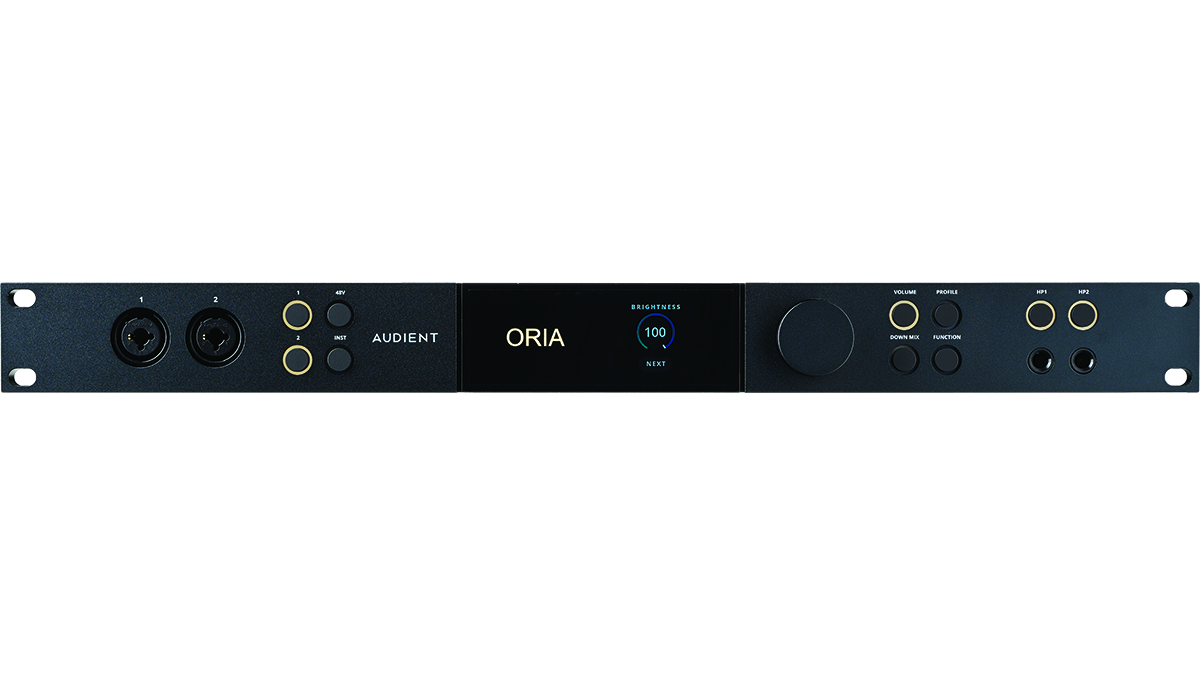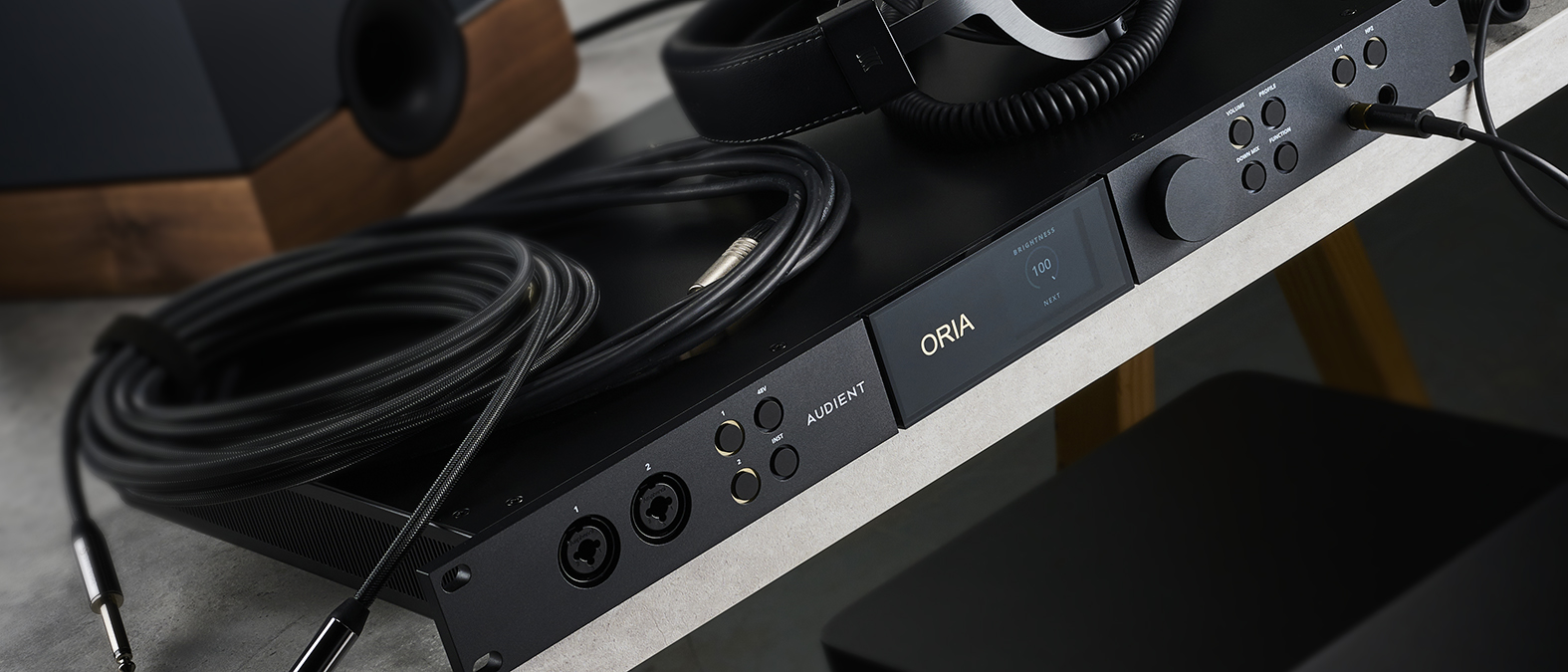MusicRadar Verdict
Audient has listened to users and delivered an immersive targeted device suitable for a broad range of multichannel applications.
Pros
- +
Neatly handles audio and monitor control for use with multi-speaker setups.
- +
Excellent desktop control app.
- +
Can be used as a standalone hardware monitor controller.
- +
Integrates directly with Dolby’s Atmos Renderer.
- +
Slick design with quality signal paths.
Cons
MusicRadar's got your back
Audient ORIA: What is it?
As immersive audio production has become more widespread, it’s become clear there is a growing demand to integrate audio interfacing and multichannel monitoring into a single, task-specific, Dolby-certified unit.
ORIA from Audient meets this need head on, but it can also be used alongside your existing interface as a dedicated multichannel monitor controller or simply as a regular USB interface.

Audient ORIA: Performance and verdict
Oria is a 18-in/24-out 24-bit/96kHz USB-C unit with an optional internal Dante expansion for an extra 16 inputs. It’s digitally controlled, software-driven and combines Audient’s motion UI display, a large rotary push button encoder and various dedicated soft buttons.
Its quality feel and slick look is complemented by premium AD/DA conversion and digitally controlled versions of Audient’s classic desk preamps. However, what makes it multichannel-focused is a unique balance of physical connectivity and onboard features. Specifically, analogue ins are limited to a pair of front-mounted mic/line/instrument inputs.

Meanwhile analogue TRS outputs include two stereo outs, two headphone outs, and 16 surround-specific outs. This means Oria can directly feed up to 9.1.6 speaker setups alongside two sets of dedicated stereo monitors.
That’s a lot of speakers, and management of these speakers is handled by Oria’s onboard DSP and controlled via the Oria desktop app (an iPad version will be available soon). The use of onboard DSP not only relieves the load on your computer CPU, but also allows Oria to run in standalone mode with settings saved to easily switchable onboard Profiles.
Within the app, regular options (main output level, mute, dim and mono) are joined by more niche settings such as global delay (0 to 100ms) and polarity, which flips the phase of the left channel and sums the left and right outputs to mono. Some of these options are replicated on the front panel, while the preamp settings are only available from the front panel.
Nevertheless, where the app really shines is with the speaker calibration, and this takes two forms. For manual alignment each speaker has individual trim (+/-12dB), delay (0 to 75ms), bass management (high pass cutoff 30 to 500Hz) and 8-band EQ alongside mute and solo.
Alternatively, Oria integrates with Sonarworks SoundID Reference for Multichannel (the box includes the SoundID calibration mic and a 60-day software licence). When we ran this, it created speaker-specific EQ curves with associated trim and delay settings.
Further handy app features include speaker groupings (fronts, subs, stereo, heights and sides) with mute and solo, multichannel metering, and the colour-coded speaker layout graphic with real time signal indicators. For Dolby Atmos, you can use Oria with DAW-integrated Dolby renderers. However, part of its Dolby Atmos certification is integration via the Dolby Audio Bridge with the Dolby Atmos Renderer.
Linking things up is easily achieved via Oria’s System settings, and once hooked up you’ll find you can switch down mix modes directly from one of Oria’s soft keys.
Pitched at serious multichannel or immersive users seeking a neat fix
Finally a word on headphones: Oria’s outputs can be switched from the default left/right feed to USB streams 17/18 or 19/20. Specify these same streams in your renderer headphone settings to allow easy access to a simultaneous binaural headphone mix.
All told, Oria is a well conceived interface that’s pitched at serious multichannel and immersive users looking for a neat all-in fix.
MusicRadar verdict: Audient has listened to users and delivered an immersive targeted device suitable for a broad range of multichannel applications.
Audient Oria: Hands-on demos
Audient
Produce Like A Pro
PresentDayProduction
Audient Oria: Specifications
- KEY FEATURES: Analogue Inputs: 2 mic/line/instrument (up to 60dB gain) Analogue Outputs: 16 surround and 2 stereo (TRS jack), 2 headphone Digital Inputs: 2 ADAT (16 channels at 44.1/48kHz, 8 channels at 88.2/96kHz) Digital Outputs: AES (25 pin D-Type) not simultaneous with the analogue outputs Interface: USB 2.0, USB Type-C connector Sync: Word Clock in and out.
- CONTACT: Audient
Jon is a London based platinum award winning mixer, producer, composer and club remixer with a diverse CV that spans dance, pop, rock and music for media. He’s also a long term contributor to MusicRadar's music technology tutorials and reviews. Whether working alone or collaborating he usually handles final mixdowns, so you’ll also find MusicRadar peppered with his handy mixing tips.
“Every one of them said yes without hesitation": Hank Marvin and Roger Taylor have just remade a '60s classic for charity
Do you know where your money goes when you buy a gig ticket? A new report breaks it down
“Every note counts and fits perfectly”: Kirk Hammett names his best Metallica solo – and no, it’s not One or Master Of Puppets














